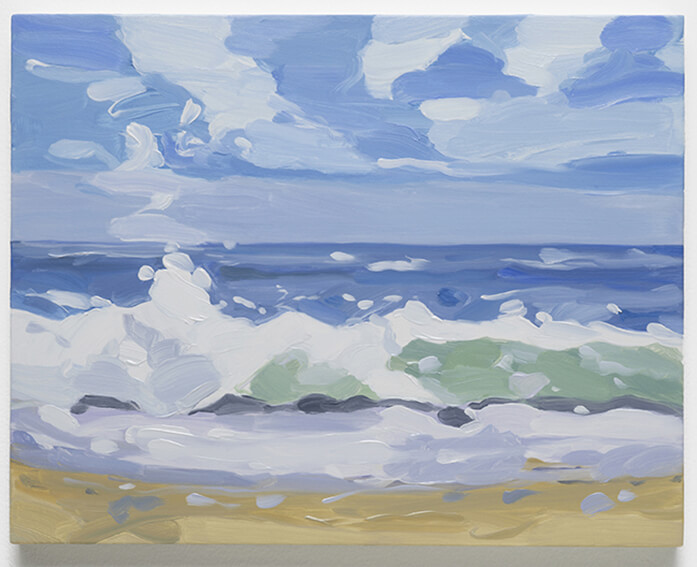I meet Niloufar Bakhtiar Bakhtiari on the Monday after Frieze week. I thought the madness was behind me. However, as soon as she greets me into her Chelsea residence in London, she tells me she will be receiving for installation, during our interview, a piece she just bought at the art fair.
PLEASE CLICK ON THE LINK BELOW TO SEE THE SHORT FILM
Of Swiss and Persian descent, Niloufar’s collection is eclectic. Her passion for art is deeply rooted on emotional attachment, memories and personal experience. She treasures her relationships with contemporary artists as much as the objects she surrounds herself with. She opens up her home collection for us and we discover this is an ever-growing work. She has never sold a single piece from her collection.
“Buying art sometimes means letting go. The hardest is to decide which work to leave behind”
Tell me about the beginning of your passion for art and how it all started.
I am half Persian half Swiss. I grew up in Switzerland. My Swiss grandfather was someone who was not only collecting but was also attentive to every single little piece that was in his house, from furniture, to rugs to a small box. It was a very curated space. It was a very particular space for that time and for Switzerland. It was very classical and modernist taste. And then on my father’s side, the Persian side, it was very colorful, very different, relaxed and laidback. My father collected already at this time. He had one painting in his office. One day I was with him in his office. My birthday was coming soon. I was about ten and he said “What are we going to do for your birthday? What would you enjoy?” and I said “That painting”. It is very classic. It is a post-impressionist Russian called Constantin Terechkovitch. This has stayed with me always. I went to study on in Paris. I was a student in a small place but this always stayed with me and it became a habit. I would always say “I want this” “I want that”.
How has your taste and your collection evolved?
When I was 20 as a student in Paris and I could barely meet ends, I would eat pasta for the rest of the month because I had bought something. I remember I started collecting nice dining plates that I love from Dior. Ridiculous when you are a 20-year old student. I would buy a plate a month. Because I like being surrounded by beautiful things. I had a more classical taste when I started which has evolved with time. Initially, I was attracted to pretty things. I still am, I think we all are very attracted to pretty things. But now I like pieces which are more conceptual and with movement and less pretty.
What has been your latest acquisition?
This neon work at Frieze by Gabriele de Santis (My Heart Will Go On, 2016). I just turned my head and it spoke to me. It is a sentence that says “My Heart Will Go On” or it can be lit to say “Art Will Go On”. It spoke to me like if I wanted to tattoo this on my body. Luckily for me it was on the young artists’ section because I could not not have bought it. It took me a split second to decide. I needed to have it. This is the magic of art because we don’t need art to live or to survive… but we do.
You own drawings by Matisse, contemporary photography, antique Persian textiles, fine art from young Middle-Eastern artists… The collection feels rooted in your heritage but at the same time it is extremely eclectic. What do you think brings all the elements together?
That is right, not everything is contemporary here. What I like is the mix. If I could afford it, I would buy old masters as well, to bring them in the mix. For me there is no rule. Voilà, this is the main thing. Some people call me irreverent. I don’t care. I respect history of art. I respect history of interior design. I respect a lot of things but it is not stiff. It is a bit like me. I am happy for people to respect me but I am happy for people to shake me slightly as well and tell me “You know, I don’t like this or you could do that better or you could be a better person”. I like putting things all the way to the wall. I like putting sculpture on the floor. It depends on the mood. There are no rules. I think with art and the way you live, it is your own rule.
What other rules are you not fond of?
I always touch. You are not meant to touch and I sneak and I touch. And it is cold or it is hard or is warm or it is completely flat or it is not… Art is a very emotional process. I have been thrown out of museums for touching. And I can tell you it is definitely worth it (laughs).
In your house, there isn’t a hierarchy of objects but a holistic approach in their understanding and arrangement. How do you feel about the compartmented disciplines when art is exhibited in museums and galleries?
I am very lucky I am not a gallery. I am not an institution. It is my home and it is my job, interior architecture. I’ve always looked at it in a way that we are doing a place to live. A place to be happy. It’s like a nest. Here it is really my safe heaven and it has always been.
To me you have two sides of art. You have people who know it, who have studied it, who have the knowledge and I love to talk to and learn from these people. But then you have my daughter, who makes a painting and it is art as well. It is a bit like poetry. When you read a poem, it is good to learn about the poem, why is it built like this, what is the artist going through, what did he want to say and to learn about the rules of poetry. But then it is good to re-read the poem and to forget about this rules. There are two ways of looking at painting. The emotional gut side that you love it or you hate it and then you learn. I love to learn from the curators and art historians but I don’t keep these compartments for myself. I break it and feel free.
Do you remember that one work you bought when you said to yourself “I am an art collector”?
I didn’t realise I was a collector until recently when Lucinda (Lovell) at the Royal Academy asked me to host an event to show my collection. I never thought about building a collection. I don’t think too much. I know that I am an art collector because I buy things I shouldn’t be buying because I can’t afford them. Last year at one of the fairs I fell in love with a piece by a Spanish artist called Jordi Alcaraz. I just couldn’t. I spoke to the gallerists and I said to him “Listen, I can’t afford it, could I pay you over some months?” And he said “Yes, not a problem”.
If we are going to call it a collection, it is not a collection made with the head. It is a collection made with the heart and with my guts. That is really the line because I like photography; I like the mirrors by Line Vautrin from the 60s; I like ultra-contemporary; I like very classical pieces but, mainly, I like the mix.
It is an addiction. I need it. I prefer not to spend on clothes. I spend on trips and travelling with my children whilst I still can because my son is 17 and he is soon going to say “Mom I want to go with my friends and party”.
You are an interior designer and the spaces you create have an emotional impact, they feel lived and alive. Where do you find inspiration?
We need to decorate our home because it is our nest. And for me, whatever surrounds me has a big influence on me. I remember a painting in my grandfather’s house that scared me. It doesn’t scare me at all any more. I love it but it scares my children. Which is very funny because maybe it’ll scare their children too. I don’t know if they will grow to love it one day or not. I am keeping it for that reason. We’ll see.
You have mentioned your children a few times. Do you think in the after-life of your collection? Would you like it to remain together or do you involve your kids in your decisions?
No, I don’t involve them really. This collection is me. However, I was very happy when I came back from Frieze and I showed my son a picture of this neon’s writing that really it took me to my guts. Art has helped me tremendously in the past years. I went through a bit of a rough patch in my private life and art has been there for me. It helped me a lot. My son said “Mom I love it. Can this one be for me?” and I said “Ok. Ok. We’ve got somewhere.”
I really try to educate them in the history of art. I always try to take them to museums to see classical exhibitions, not just contemporary art. I don’t think you can really understand contemporary art if you don’t have some references. And a lot of artists do use these references.
You are a patron for the Tate. How do you think the US model of patronage has influenced public galleries in Europe?
To me the big difference, and future will tell us, is that a lot of these patrons in the US like to have their name. I think this is fabulous and I am not criticizing it in any way. In the States you have whole museums, and god-damn good ones, led privately. We are not there yet here because patrons in Europe are a bit more discreet. A lot of them do not even want their name mentioned. I am hoping this is what will keep it going on. This is where they have hit a wall in the States right now.
What is next? Is there an artist or artwork in your radar?
Olafur Eliasson, most definitely. I know I can’t live in The Weather Project at Tate or in Versailles (two recent institutional commissions) but I love he has started to make some pieces… It is a pity it is not here, because I move stuff around. It is in my room. I have this Lalique crystal ball that I love. It reminds me of Eliasson’s work. It has been following me forever.
Eliasson’s work talks to me a lot. He talks about the sun and the moon. Full moon, I can’t sleep. You don’t want to meet me that day. I don’t have enough sunshine and I go like this (gestures as if shrinking). He has started making pieces that you can actually buy and have in your home. We don’t all have the space and the means to collect visual arts that need an installation. I saw two pieces by him at Frieze and I think if I could… (laughs).




